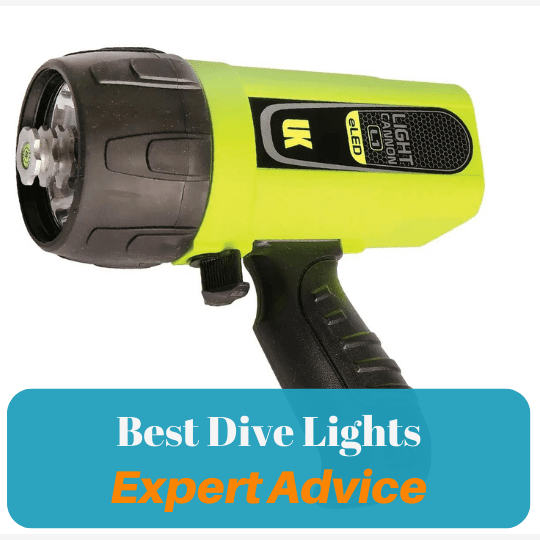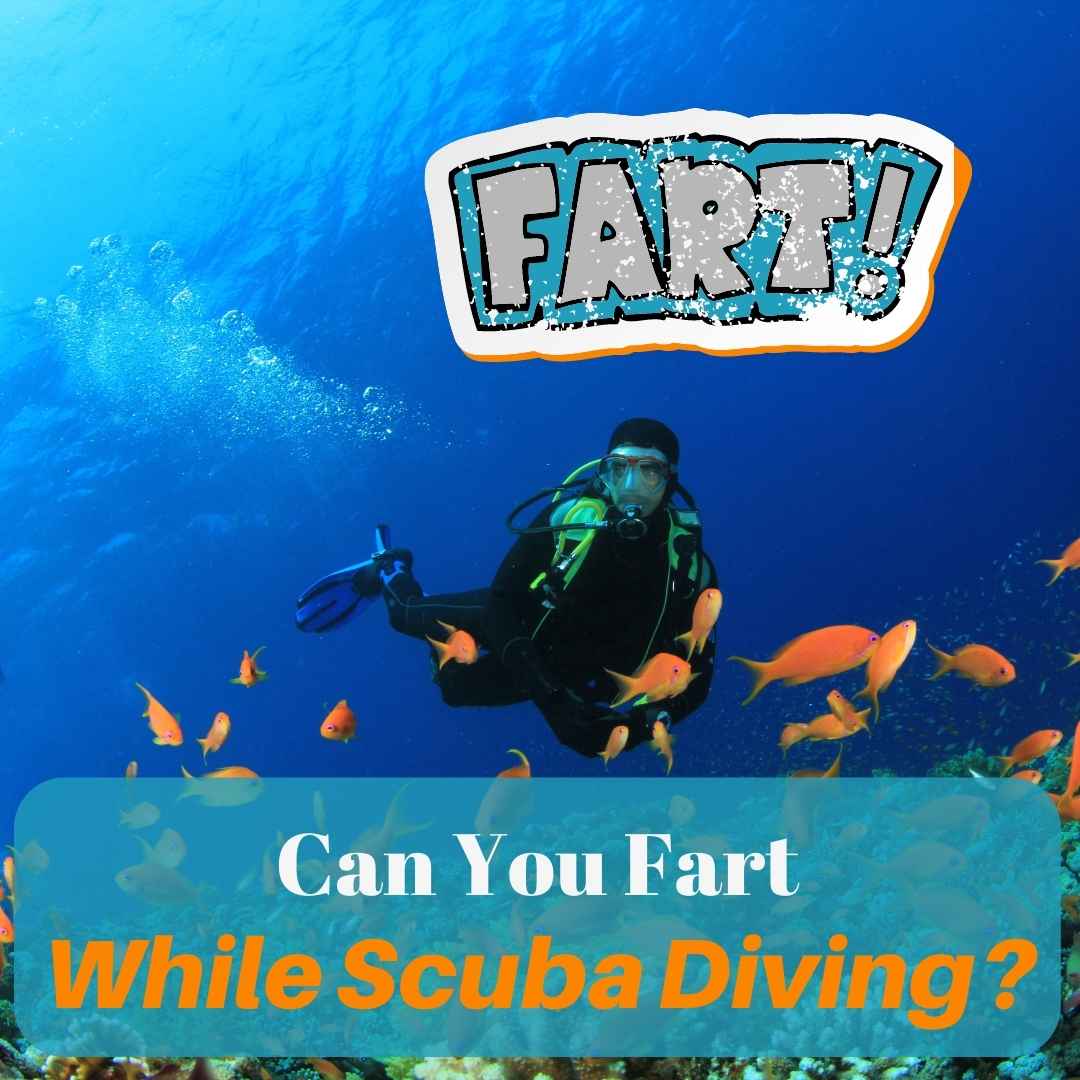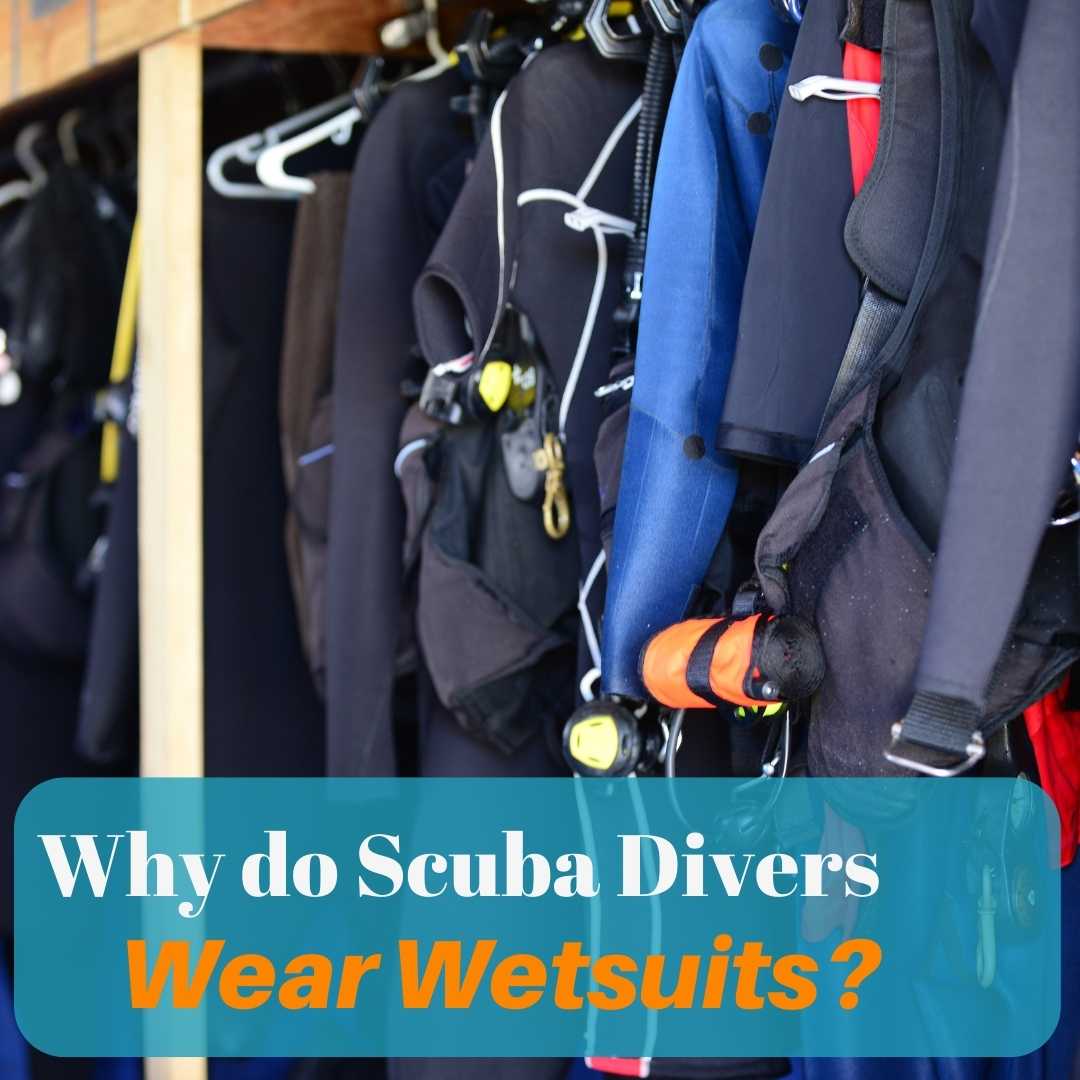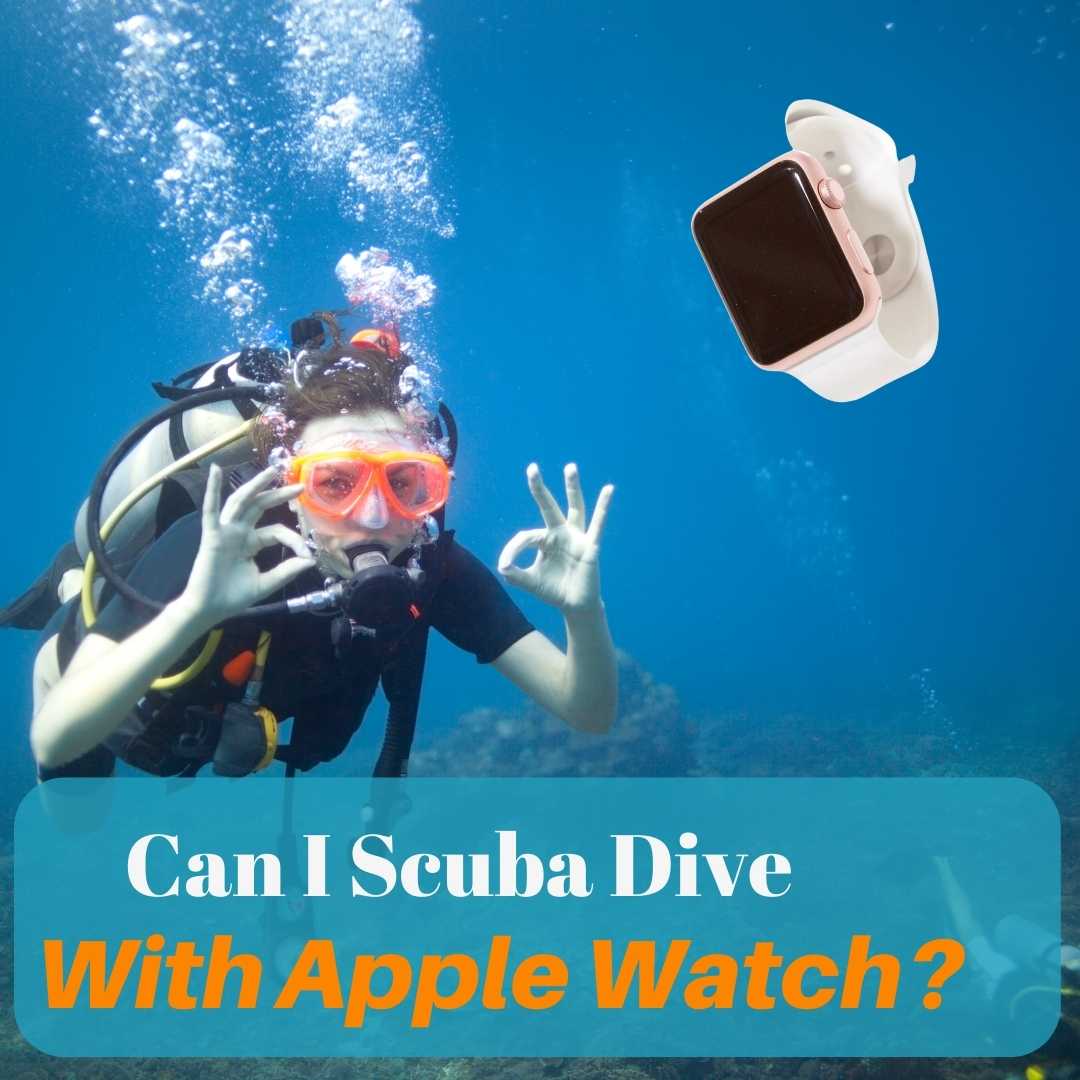Color has an interesting relationship with depth. As depth increases, color vanishes. It vanishes in the same order in which it appears in the rainbow. Red goes first, then violets, followed by ultra-violets. Since diving can become a colorless and bland experience, diving lights can greatly enhance the experience of a dive.
Furthermore, diving during the night has its own charm. There are a lot of critters that come out during the night, and the marine life you see at night, on the same dive site, could be quite different from what you see during the day. Thus, night diving brings its own need for underwater lights.
Low visibility conditions also demand proper lights. There are some amazing wrecks that are sitting in reduced visibility and, in order to enjoy them, you have to bring a suitable light source. Lastly there are underwater photographers and videographers who like to shoot colorful videos and photos and they need light to bring out the colors.
The underwater lights market is huge. In this article, we are going to look at some of the best diving lights that are available out there for the recreational divers and what we like and do not like about them.
Table of Contents
Top Picks for Best Dive Lights
- Best Overall – Big Blue CF 1200
- Best for Battery Life – Dive Rite LX 20
- Best for Strong Beam – Light & Motion SOLA
- Best Budget Dive Light – Scubaforce Powerlight 2
- Best Video Light – Sea Dragon 2000F
Big Blue CF 1200
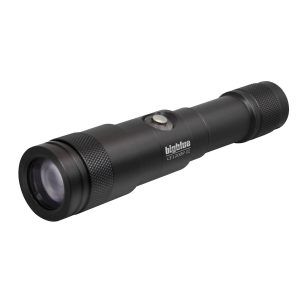
If all the recreational divers in the world could be given just one dive light for all their recreational diving, then I would pick Big Blue CF1200. Simple to charge, simple to use and easy to carry. Not only does it give out 1200 lumens at its maximum output, but it also gives the option of varying the beam angle, from an extremely narrow 7 degree spot to a wider 37 degree angle.
Its rechargeable battery will give two hours of burn time at its highest setting and since it runs on a rechargeable, lithium-ion 18650 battery, users can own multiple of these to replace on the field in case need be.
Pros:
- Ease of use and reliability. This is one light that can be appreciated for its simplicity and reliability
- No multiple batteries to charge and no fancy options
Cons:
- Cost effective. When you remove the bells and whistles, costs will go into what is essential. Thus what you have is a simple light that is very reasonably priced for what it does.
Dive Rite LX 20
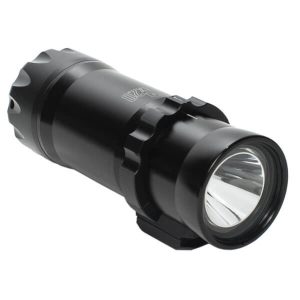
This dive light was designed for cave divers but has gained popularity among recreational divers as well, due to its compact handling and powerful beam. It is designed to not leave you in the dark. On its highest power mode, it will give you 1500 lumens for up to 2.5 hours of consistent burn time. This can be increased to 3 hours on medium burn where it will give you 750 lumen and if you drop it down to 350 lumen, then it will give you 6 hours of low beam.
The light monitors its own battery voltage and will decrease light output to increase its burn time. In this power save mode, it will give you 75 lumens with a burn time of thirty hours so that you are never left in the dark.
Pros:
- There are two things that reduce a divers visibility. One is darkness and the other, suspended particulates. The LX-20 performs well in both scenarios. Its strong and narrow 12 degree beam can cut through sediment in a silt-out situation. No wonder it is preferred by cave and wreck divers
- Its ability to adjust its burn time to never leave you in the dark
Cons:
- This is a compact but heavy light and will feel heavier on the hand. It is meant to go on a good man handle for ease of handling
- Users should be ready to pay for an entry level technical diving light, instead of a recreational one because while it is popular with some recreational divers, the LX 20 is a serious technical diving and cave light
Light & Motion SOLA
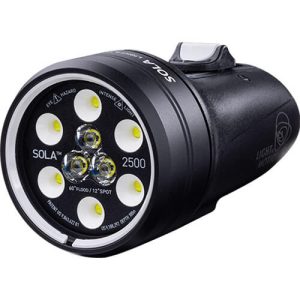
This dive light delivers 2500 lumens and, in the recreational diving community, where divers prefer to carry lights without cords and canisters, it will be hard to find something that would be stronger.
One thing that gives this light and additional “punch” is its ability to adjust beam angle. It can serve as a spot light and well as a flood light, where you are trying to disperse light over a wider and closer area.
Depending on which beam angle you select, LM 2500 will deliver 50 to 60 minutes on high mode, 100 minutes on medium and 200 minutes on low modes.
Pros:
- There are dives on which you would want to spread light over a wider area and then there are situations in which you want to shoot a strong narrow and strong beam as far out as possible. It is probably the most versatile light on the market for recreational divers as it gives you the ability to choose between a narrow spot beam or a wider filling flood mode. There are not a lot of underwater situations where this one would not be appropriate
Scubaforce Powerlight 2
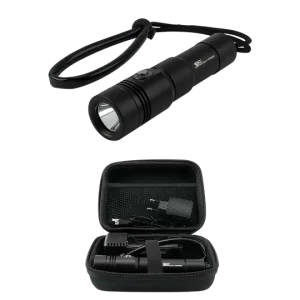
If you want an entry level light that is compact, easy to manage and reliable, then Scubaforce Powerlight-2 is definitely worth a mention. It delivers 1000 lumens of power, in a narrow 12 degree spot beam and can run for a good 90 to 100 minutes on its highest power. Its small and compact size makes it an ideal for new divers who want a simple light for a typical recreational dive.
Pros:
- Compact size. This “clip and forget” light only weighs 180 grams excluding the battery. It is very easy to manage and can be worn consistently above the wrist without the diver noticing its weight
- Price! Forget the high powered canons. If you want a small light that does the job, Scuba Force Powerlight2 will do
Cons:
- Limited battery life. You may need to carry 2 batteries for a longer day underwater
Ideal Use: If you are a new diver who is starting out in diving and wants to reduce bulk and task loading then Scubaforce Powerlight 2 will do you well. It also serves as a good back up light for its small size and attaching convenience.
Best Dive Lights for Video
In order to select a video light, we must first understand what it does and how it is different from a regular video light. For general diving purposes, a narrow beam is preferred, as it shoots the farthest and can cut through bad visibility better. Video lights need a different design concept.
Underwater cameras, especially recreational and user friendly ones like the GoPro have very wide angle lenses. These are designed to the widest perspective and bring it within the frame. These require a wide spreading light to paint the largest area in front of them. After reviewing a few video lights, the following stood out.
Sea-Life Sea Dragon 2000F
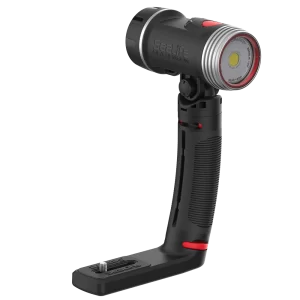
The Sea Dragon throws out 2000 Lumens and has an angle which is 120 degrees on surface and 90 degrees underwater. It will run for a good 60 minutes at full power.
This is a versatile video light that can fit a very large variety of trays and camera mounts.
Notable Mentions
There are plenty of high quality lights out there and the following list will introduce you to what else is out there and the best purposes for each.
Apeks Luna
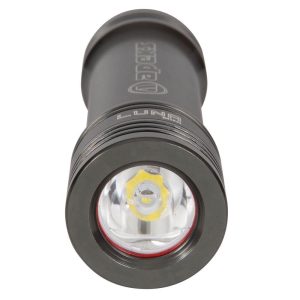
Along with Dive Rite’s LX 20, the Luna Mini is also one of those technical diving lights that has gained a following among recreational divers. With its 2000 lumen beam it is stronger than Dive Rite’s LX 20, but what it gains in output, it loses in run time. While the LX 20 will reduce its output to 75 lumens to burn for 30 hours, Apeks Luna will give 8 hours at its lowest settings.
Nevertheless, Luna is a magnum among cordless dive lights and will serve recreational divers well in night diving and low visibility environments.
Pros:
- Most lights in this category will shoot a narrower beam at a 12 degree angle. This one generates a powerful beam that is projected at a 20 degree angle. It does a good job in dispersing light over a slightly wider angle without weakening the beam
- Internal Thermal Management System! Lights with strong output can get dangerously hot, especially if they are left turned on outside of water. Lune Primary comes with a patented circuit system within the light which will regulate output to prevent overheating
Cons:
- Expensive! If you want a magnum, you must pay for a magnum
Ideal Use: This light will serve well in the hands of advanced recreational divers, who are night diving or exploring in low visibility. Divers would often lose each other in low vis conditions but with a light such as Luna Prima Torch, your dive buddies beam can make itself visible through a lot of muck.
Underwater Kinetics Light Cannon L1
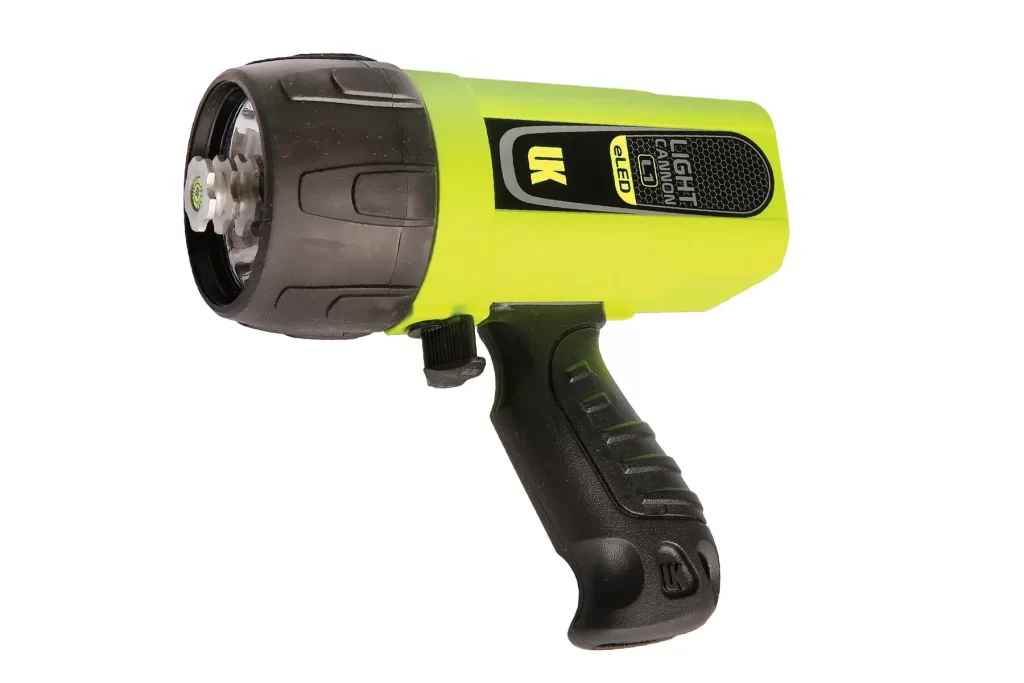
This is also one of those lights that attempt to never leave you in the dark. It delivers 1100 lumens and can be dialed down to 440 lumens to get a burn time of 16 hours! This is also one of those lights that can be purchased in pistol grip as well as a lantern style top grip.
Pros:
- This is one of the fewer lights out there which can be powered by 8 C cell alkaline batteries as well as a rechargeable battery. If you are a traveling diver going to a remote destination where batteries may not be available and airlines will not allow you to bring your own then the light will not give up on you. And, if you run out of battery charge during an important trip, as long as you have your back up alkaline batteries, you would still have a light. The optional rechargeable battery pack will allow you to raise the output to 2100 lumen for 2 hours in high mode
Cons:
- The body is a plastic compound instead of metal. Now don’t get me wrong. This is no ordinary plastic but a tough plastic composite that does not scratch or chip and is also resistant to corrosion. Nevertheless, the material does not have as much history of use behind it as metal
Ideal Use: The Canon L1 will make a great travel light. The dual battery input allows it to be powered by alkaline as well as rechargeable batteries.
Big Blue AL1800NP
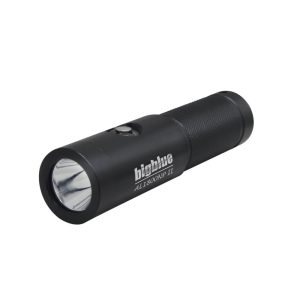
Here is another light that looks small but delivers big. The side of AL800 may not convince you that it gives out 1800 lumens but that is exactly what this one delivers, and that also for straight two hours. You will get 1900 lumens for four hours, 450 lumens for eight hours and 180 lumens for 20 hours. This would give any diver all sorts of options to balance battery life with power.
With an anodized aluminum frame and a lens made from tempered glass, the AL1800, like all other Big Blue lights, is meant for long term use and an engineering ethic that prioritizes durability. The light should serve you through all sorts of recreational diving situations.
Pros:
- This light is powerful enough to be a technical diving light yet small and compact enough to appeal to the recreational diving market
- Its four output levels allow you to go from various combinations of outputs and well as burn times,and give you the ability to vary these depending on the dive
Cons:
- Its 10 degree spot beam is one of the narrowest in the market
Frequently Asked Questions
Do I Need a Dive Light?
Good question. If you are a new diver who is getting comfortable in the water, then managing a light may add unnecessary task loading. Tasks that seem very easy and simple on the surface may need a little experience under water and managing accessories such as cameras, lights and DSMBs etc. need a diver who has achieved a level of proficiency, where they can now be given something to do in addition to diving.
Purpose of specialties such as night diving and photo specialty etc. is to develop this task loading expertise under instructor supervision. So if you are a new diver who is still learning basics of diving such as propulsion and buoyancy, then it is better to leave gadgets out and choose a dive site that will not require any. You may see that sometimes marine life shies away from divers who approach an area with headlights on.
But if you have a little bit of experience and you wish to explore environments such as night and low visibility areas, or you would like to see color, then lights can really enhance the quality of the dive. In this write up, we will look at a selection of dive lights, from various categories and go over what we like and do not like in each. Here we go!
How Many Lumens Do I Need for A Dive Light?
The answer to this depends on the ocean conditions, your personal preferences and on what you are trying to do. As mentioned earlier, color disappears with depth and a lot of times, divers carry lights during the day to paint their dives. Depending on the conditions, underwater lights can also illuminate suspended particles in the water and reduce visibility.
Entry level dive lights are general purpose dive lights that are designed to be used by recreational divers so a lumen of 200 or greater would suffice for most recreational diving needs. Now, if you are on a night dive and do not want to scare the critters away, then 500 lumen or below should be up to task. Then you can go up to 1000 lumens for additional brightness or to throw a narrow beam far out, but 200 to 1000 is the range that is normally sufficient in the hands of most recreational dives.
What Lights Do Divers Use?
Generally, in the world of recreational diving, lights would fall into three categories. There are primary lights, which have a longer burn time and are meant to address a lot of lighting scenarios from day to night dives etc.
Then there are secondary lights that are meant to be used when the primary fails. These are compact, easy to stow but may not have the same burn time as these will be deployed when the dive is being terminated.
Video lights are also gaining popularity among recreational divers as many have realized how colorful their videos can get if you add lights to them. Instead of a narrow beam that travels outwards, video lights are intended to spread over a wide area and are meant to add color within a certain distance from the camera lens.
Conclusion
For most people, it is our desire to see something that takes us beneath the waves. If scuba diving was a blind experience, not many of us would pursue this path. Interestingly, seeing underwater is a complex science where depth, color, light, water conditions and our distance from the object, all negotiate with each other to give us an image.
The moment you hold a light underwater, you are now holding the single most powerful instrument of negotiations in your own hands. You become an artist that paints a bland landscape with colors that have been pre-determined by nature. Your diving experience can be enhanced considerably with the right torch.
Then certain conditions such as night and low visibility diving demand their own lighting. In order to brave these environments, lights can no longer be seen as an artistic luxury but something much more essential. Whenever your progress into more advanced forms of diving, there are lights out there that are designed for such conditions.
Lastly, lighting for the camera lens is a much different science than lighting for the eye. Value of a wider spreading flood light gets appreciated when you see the same underwater scene from behind the camera’s viewfinder. No matter what your motivation is, it is important to get the appropriate training, select the right tool and dive with safety as the top priority.

